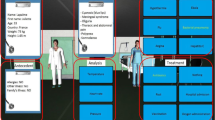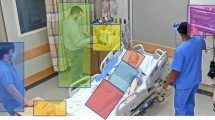Abstract
We report an eye tracking experiment conducted on a virtual pediatric patient system to determine the effect of different visual interface layouts on the amount of visual interaction of student nurses with a virtual mother-child dyad. The results of this experiment provide insight into the tradeoffs between using animated or non-animated virtual patients and relative advantages/disadvantages of interacting with the system though a tablet interface.
Access this chapter
Tax calculation will be finalised at checkout
Purchases are for personal use only
Preview
Unable to display preview. Download preview PDF.
Similar content being viewed by others
References
Pence, T.B., Dukes, L.C., Hodges, L.F., Meehan, N.K., Johnson, A.: The effects of interaction and visual fidelity on learning outcomes for a virtual pediatric patient system. In: 2013 IEEE International Conference on Healthcare Informatics (ICHI), pp. 209–218. IEEE (2013)
Stevens, A., Hernandez, J., Johnsen, K., Dickerson, R., Raij, A., Harrison, C., DiPietro, M., Allen, B., Ferdig, R., Foti, S.: The use of virtual patients to teach medical students history taking and communication skills. American Journal of Surgery 191(6), 806–811 (2006)
Hubal, R.C., Frank, G.A., Guinn, C.I.: Lessons learned in modeling schizophrenic and depressed responsive virtual humans for training. In: Proceedings of the 8th International Conference on Intelligent User Interfaces, pp. 85–92. ACM (2003)
Hockenberry, M.J., Wilson, D.: Wong’s nursing care of infants and children. Mosby/Elsevier (2007)
Planas, L.G., Er, N.L.: A systems approach to scaffold communication skills development. American Journal of Pharmaceutical Education 72(2) (April 15, 2008)
Durham, C.F., Alden, K.R.: Enhancing patient safety in nursing education through patient simulation. Patient Safety and Quality: An Evidence-Based Handbook for Nurses 6(3), 221–250 (2008)
Ball, J.W., Bindler, R.C., Cowen, K.: Child health nursing. Prentice Hall (2013)
Chant, S., Jenkinson, T., Randle, J., Russell, G.: Communication skills: some problems in nursing education and practice. Journal of Clinical Nursing 11(1), 12–21 (2002)
Johnsen, K., Dickerson, R., Raij, A., Lok, B., Jackson, J., Shin, M., Hernandez, J., Stevens, A., Lind, D.S.: Experiences in using immersive virtual characters to educate medical communication skills. In: Proceedings of Virtual Reality, pp. 179–186. IEEE (2005)
Péruch, P., Vercher, J.L., Gauthier, G.M.: Acquisition of spatial knowledge through visual exploration of simulated environments. Ecological Psychology 7(1) (1995)
DeVault, D., Artstein, R., Benn, G., Dey, T., Fast, E., Gainer, A., Georgila, K., Gratch, J., Hartholt, A., Lhommet, M.: Simsensei kiosk: a virtual human interviewer for healthcare decision support. In: Proceedings of the 2014 International Conference on Autonomous Agents and Multi-Agent systems, pp. 1061–1068. International Foundation for Autonomous Agents and Multiagent Systems (2014)
Gulz, A., Haake, M.: Design of animated pedagogical agents – a look at their look. International Journal of Human-Computer Studies 64(4), 322–339 (2006)
Jacob, R.J., Karn, K.S.: Eye tracking in human-computer interaction and usability research: Ready to deliver the promises. Mind 2(3), 4 (2003)
Poole, A., Ball, L.J.: Eye tracking in hci and usability research. In: Ghaoui, C. (ed.) Encyclopedia of Human-Computer Interaction (2006)
Riley, W., Davis, S., Miller, K., Hansen, H., Sainfort, F., Sweet, R.: Didactic and simulation nontechnical skills team training to improve perinatal patient outcomes in a community hospital. Joint Commission Journal on Quality and Patient Safety 37(8), 357–364 (2011)
Law, B., Atkins, M.S., Kirkpatrick, A.E., Lomax, A.J.: Eye gaze patterns differentiate novice and experts in a virtual laparoscopic surgery training environment. In: Proceedings of the 2004 Symposium on Eye Tracking Research & Applications, pp. 41–48. ACM (2004)
Mello-Thoms, C., Nodine, C.F., Kundel, H.L.: What attracts the eye to the location of missed and reported breast cancers? In: Proceedings of the 2002 Symposium on Eye Tracking Research & Applications, pp. 111–117. ACM (2002)
(Gazepoint), http://gazept.com/
Dukes, L.C., Pence, T.B., Hodges, L.F., Meehan, N., Johnson, A.: Sidnie: scaffolded interviews developed by nurses in education. In: Proceedings of the 2013 International Conference on Intelligent User Interfaces, pp. 395–406. ACM (2013)
Nielsen, J.: The nielsen norman group (2002)
Brooke, J.: Sus-a quick and dirty usability scale. Usability Evaluation in Industry 189, 194 (1996)
Mortensen, J., Vinayagamoorthy, V., Slater, M., Steed, A., Lok, B., Whitton, M.: Collaboration in tele-immersive environments. In: Proceedings of the Workshop on Virtual Environments, pp. 93–101. Eurographics Association (2002)
Salvucci, D.D., Goldberg, J.H.: Identifying fixations and saccades in eye-tracking protocols. In: Proceedings of the 2000 Symposium on Eye Tracking Research & Applications, pp. 71–78. ACM (2000)
Author information
Authors and Affiliations
Editor information
Editors and Affiliations
Rights and permissions
Copyright information
© 2014 Springer International Publishing Switzerland
About this paper
Cite this paper
Pence, T.B., Dukes, L.C., Hodges, L.F., Meehan, N.K., Johnson, A. (2014). An Eye Tracking Evaluation of a Virtual Pediatric Patient Training System for Nurses. In: Bickmore, T., Marsella, S., Sidner, C. (eds) Intelligent Virtual Agents. IVA 2014. Lecture Notes in Computer Science(), vol 8637. Springer, Cham. https://doi.org/10.1007/978-3-319-09767-1_43
Download citation
DOI: https://doi.org/10.1007/978-3-319-09767-1_43
Publisher Name: Springer, Cham
Print ISBN: 978-3-319-09766-4
Online ISBN: 978-3-319-09767-1
eBook Packages: Computer ScienceComputer Science (R0)




